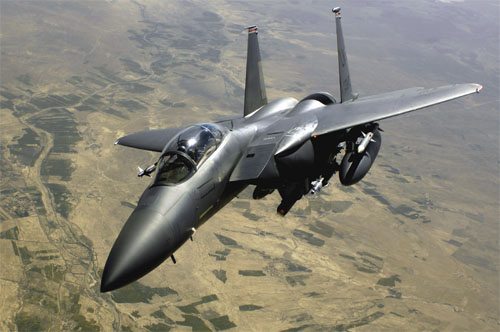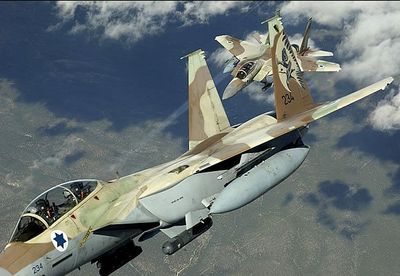INTRODUCTION
The Eurofighter Typhoon (EF-2000) is a result of joint efforts on the part of UK, Germany, Italy and Spain to develop a 5th Generation fighter capable of engaging all contemporary threats like the Flanker and Fulcrum series of fighters. The aircraft was designed with Air Dominance as its primary mission, and ground attack being the secondary. To achieve better combat performance than the enemy fighters, the Eurofighter Typhoon had to be endowed with features like unstable design, carefree handling, advanced sensor suite and defensive counter-measures, ultra long-range missiles and a top-end cockpit.
DESIGN
To achieve high instantaneous and sustained performance, the configuration chosen was Delta wings with canards. This unstable design is controlled by an advanced quadruplex Active Control Technology (ACT) fully digital system. The canards are placed closer to the nose, unlike the ones in Rafale and Gripen. This allows an increase in AoA, with a little compromise in sideways view from the canopy. The sturdy structure of the Typhoon allows it to operate from rough airfields.
AVIONICS SUITE
From the very beginning, the Eurofighter Typhoon (EF-2000) was designed to employ a high level of sensor-fusion to help reduce pilot workload during combat. This allows the Eurofighter Typhoon pilot to create a better picture of the whole combat scenario and therefore he can act in a better manner.
Combining all data streams from the major on-board sensors conjunction with any information obtained from external and off-board platforms such as JSTARS, ASTOR, AWACS or even other Eurofighter’s via the Multi-function Information Distribution System, the AIS gives pilots unprecedented awareness of the situation in the sky and allows them to concentrate on their task to carry out the mission. Equipments such as the DASS, navigation, ACS and communications are also integrated into the AIS.
ECR-90 CAPTOR
The CAPTOR radar is the primary sensor of the Typhoon. It is a third generation coherent X-band (8 to 12 GHz) multi-mode Pulse Doppler system developed from GEC’s Harrier FA.2 Blue Vixen system. Some features of the CAPTOR system are –
• It uses DAS (Data Adaptive Scanning) to provide accurate information on selected targets and minimizes unnecessary antenna movement.
• For Close Combat, CAPTOR switches to High Precision Single Target Track.
• The Synthetic Aperture Radar (SAR) mode offered by Tranche-1 Eurofighter’s gives a 1m resolution (with improvement due in Tranche-2)
• The CAPTOR is mechanically scanned radar, yet it is able to interleave different modes due to exceptional scan rates (credited to the Low inertia non-counterbalanced antenna coupled with four high torque, high precision samarium-cobalt drive motors)
• To increase effectiveness in a heavy ECM situation, the CAPTOR has a dedicated Third Channel to screen ECM sources. When performance degradation is detected in the radar, the AIS compensates by using other sensors.
• 61 Shop Replaceable Items (or SRIs) and around 6 Line Replaceable Units (or LRUs) enable the CAPTOR to be upgraded easily and give a quick maintenance turn-around.
• Tests conducted in 1997 showed that CAPTOR could track fighter-sized targets at a range of 160 kms. While this seems an exaggerated range for mechanically scanned radar, the range of the CAPTOR radar is bound to be impressive.
• Capable of tracking 20 targets, the CAPTOR has a range accuracy of 10m, and can obtain a target angle within 1 mm.
In the coming years, the CAPTOR will be replaced by AMSAR (Airborne Multi-mode Solid-state Active-array Radar). This radar will equip both the European fighters – the Typhoon and the Rafale (France).
PIRATE IRST
In the modern combat scenario, an aircraft constantly using its radar is target practice for the enemy. To reduce the usage of radar, a few measures or a combination of these measures is followed. First is the use of secure-datalinks to download information from sources such as AWACS, JSTARS, GC and even other fighters having this capability. Second is to use Passive systems like Infrared sensors, something that the Russian fighters have been using since a long time.
PIRATE system in the Eurofighter Typhoon (EF-2000) is designed to allow the Eurofighter to scan the airspace covertly. If a target is found, radar can be opened and an attack can be commenced. It incorporates both a Forward Looking Infra Red (FLIR) and Infra Red Search and Track (or IRST) capability. The system itself utilizes a highly sensitive Infra Red sensor mounted to the port side of the canopy. This equipment scans across wavelengths from 3 to 11 µm in two bands. This allows the detection of both the hot exhaust plumes of jet engines as well as surface heating caused by friction. Super cooling the sensor can allow detection of even small variations in temperature detected at long range. Although no definitive ranges have been released an upper limit of 80nm has been hinted at, a more typical figure would be 30 to 50nm. The actual output from the system can be directed to any of the Multi-function Head Down Displays mounted within the cockpit. Additionally the image can be overlaid on both the Helmet Mounted Sight and Head Up Display.
The IIR sensor is stabilized within its mount so that it can maintain a target within its field of view. Up to 200 targets can be simultaneously tracked by the system using one of several different modes; Multiple Target Track (MTT), Single Target Track (STT), Single Target Track Identification (STTI), Sector Acquisition and Slaved Acquisition.
This system allows the Typhoon to attack target without the use of CAPTOR. Additionally, it allows the Typhoon to engage targets in the heaviest of ECM conditions.
ARMAMENT
One of most striking features of the Eurofighter Typhoon (EF-2000) is its internal cannon. It is equipped with a single Mauser GmbH developed BK-27 cannon mounted internally in the fuselage forward of the starboard wing. It utilizes 27mm high explosive shells with a maximum firing rate of some 1700 rounds a minute; each aircraft will likely carry approximately 150 rounds.
The weapon apparently looks weaker than the 20mm M-61 cannon with a rate of 6000 rounds a minute. But in a fast dogfight, the Mauser will pour 4 kg of ammo in 0.5 seconds while M-62 would have poured only 2 kg. By the time M-61 reaches full firing rate, the target may be moved considerably. This is particularly if the pilot wishes to take snap-shots.
Due to cannon’s ability to engage moving targets swiftly and with accuracy, the system was fitted with an automatic firing mode. When the radar solution shows that the target is passing through the line-of-fire of the cannon, it will fire a burst of 27mm and this can be quite helpful in maneuvering fights.
The primary BVR weapon of the Eurofighter Typhoon (EF-2000) will be the MBDA Meteor rocket-ramjet powered BVRAAM with range well over 100 kms. The missile will be guided using a mix of mid-course correction using data-link, inertial guidance and active radar in terminal stage.
The primary close-combat weapon of the Typhoon will be the AIM-132 ASRAAM 4th generation AAM. The missile has the capability to engage targets that are high off-boresight. When used with the HMS, it forms a formidable weapon system.
Other air-air weapons include AIM-9 Sidewinder, AIM-120 AMRAAM, Skyflash, Aspide and IRIS-T.
In air-ground mode, the Eurofighter Typhoon (EF-2000) employs the most modern line of precision guided bombs and standoff missiles. Its arsenal includes Storm Shadow and Taurus standoff missiles, Harpoon and Penguin AShMs, ALARM and HARM ARMs, Brimstone anti-vehicle missile, JDAM and LGBs, BL-755 and DWS-39.
SELF-DEFENSE
The Eurofighter Typhoon (EF-2000) utilizes the DAC (Defensive Aids Computer) to create a 360-degree coverage of all threats around the aircraft. The DAC fuses all information from the RWR, MAW and LWR (RAF only).
While the current MAW is an active system, the PIMAW is under development, which will allow detection of missile command links passively. The LWR or Laser Warning Receiver is unique to the RAF Typhoon and allows the system to detect and Lasers that are being directed on the aircraft. This takes away the covert attack capability possessed by Laser-Range Finder and IRST equipped Fulcrum and Flanker series of aircrafts.
Apart from these systems, the Typhoon uses standard Chaff and Flare dispensers, ECM system and also Towed Decoys to defeat any incoming weapons.
PROPULSION
The EJ200 is an advanced design based on a fully modular augmented twin-spool low bypass layout. At its maximum dry thrust of 60kN (or 13,500lbf) the EJ200’s SFC is in the order of 23g/kN.s. With reheat the engine delivers around 90-100kN (or 20,250-22,500lbf) of thrust with an SFC of some 49g/kN.s.
The engine allows the Eurofighter Typhoon (EF-2000) to achieve super-sonic speed (up to Mach 1.5) without the use of re-heat and also gives the it a very high Thrust-to-weight ratio, a factor that is vital in all forms of air combat.
Eurofighter Typhoon Specifications
|
|
|
Wing Span
|
10.95m
|
|
Length
|
14.96m
|
|
Height
|
5.28m
|
|
Wing Area
|
50m²
|
|
Fore plane Area
|
2.4m²
|
|
Empty Weight
|
9750 kg (approx)
|
|
Internal Fuel Load
|
4000 kg (approx)
|
|
External Store Load
|
6500 kg (approx)
|
|
Max T/O Weight
|
21000 kg
|
|
Power
|
· 2 EJ200 Turbofan Engines
· 20,000 lbf (90 kN) each with Afterburner
· 13,500 lbf (60 kN) each without Afterburner
|
|
Maximum Speed
|
2125 km/hr
|
|
Time to 10670m
|
2.5 minutes
|
|
Runway Requirement
|
700m
|
|
T/O run
|
· 300m
· Air combat mission
|
|
Combat Radius
|
· Ground attack, lo-lo-lo: 601 km
· Ground attack, hi-lo-hi: 1389 km
· Air defense with 3hr CAP: 185 km
· Air defense with 10-min loiter: 1389 km
|
|
G Limits
|
+9/-3 w/ internal fuel and two AIM-120
|
|
Weapons & Stores
|
· Internally mounted 27mm Mauser gun
· Total of 13 external stores stations: 5 (incl one wet) under fuselage and 4 (incl one wet) under each wing
· Mix of Beyond Visual Range Air-to-Air Missiles (BVRAAM) and Short-Range Air-to-Air Missiles (SRAAM) carried externally
· Four BVRAAM under fuselage in semi-conformal carriage configuration
· Laser guided bombs
· Advanced anti-armour weapons
· Conventionally armed stand-off missiles
|
[ppgallery id=”3″]
Written by: Dhruv Shukla (DefenceTalk Member)









